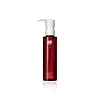What's inside
What's inside
 Key Ingredients
Key Ingredients

No key ingredients
 Benefits
Benefits

 Concerns
Concerns

 Ingredients Side-by-side
Ingredients Side-by-side

Zea Mays Oil
EmulsifyingEthylhexyl Palmitate
EmollientPersea Gratissima Oil
Skin ConditioningHelianthus Annuus Seed Oil
EmollientOlea Europaea Fruit Oil
MaskingSimmondsia Chinensis Seed Oil
EmollientRosa Canina Fruit Oil
EmollientTocopherol
AntioxidantCamellia Japonica Seed Oil
EmollientPanax Ginseng Seed Oil
EmollientSorbeth-30 Tetraoleate
EmulsifyingPogostemon Cablin Leaf Oil
MaskingMelia Azadirachta Extract
Skin ConditioningMoringa Oleifera Seed Oil
EmollientArgania Spinosa Kernel Oil
EmollientSqualane
EmollientHippophae Rhamnoides Oil
EmollientBisabolol
MaskingZea Mays Oil, Ethylhexyl Palmitate, Persea Gratissima Oil, Helianthus Annuus Seed Oil, Olea Europaea Fruit Oil, Simmondsia Chinensis Seed Oil, Rosa Canina Fruit Oil, Tocopherol, Camellia Japonica Seed Oil, Panax Ginseng Seed Oil, Sorbeth-30 Tetraoleate, Pogostemon Cablin Leaf Oil, Melia Azadirachta Extract, Moringa Oleifera Seed Oil, Argania Spinosa Kernel Oil, Squalane, Hippophae Rhamnoides Oil, Bisabolol
Corylus Avellana Seed Oil
EmollientCaprylic/Capric Triglyceride
MaskingOlea Europaea Fruit Oil
MaskingSorbitan Oleate
EmulsifyingPersea Gratissima Oil
Skin ConditioningCamellia Japonica Seed Oil
EmollientArgania Spinosa Kernel Oil
EmollientSimmondsia Chinensis Seed Oil
EmollientScutellaria Baicalensis Root Extract
AstringentPaeonia Suffruticosa Root Extract
Skin ProtectingGlycyrrhiza Glabra Root Extract
BleachingLactobacillus
Skin ConditioningAniba Rosaeodora Wood Oil
AstringentCitrus Aurantium Bergamia Fruit Oil
MaskingGeranium Maculatum Oil
MaskingParfum
MaskingCorylus Avellana Seed Oil, Caprylic/Capric Triglyceride, Olea Europaea Fruit Oil, Sorbitan Oleate, Persea Gratissima Oil, Camellia Japonica Seed Oil, Argania Spinosa Kernel Oil, Simmondsia Chinensis Seed Oil, Scutellaria Baicalensis Root Extract, Paeonia Suffruticosa Root Extract, Glycyrrhiza Glabra Root Extract, Lactobacillus, Aniba Rosaeodora Wood Oil, Citrus Aurantium Bergamia Fruit Oil, Geranium Maculatum Oil, Parfum
Ingredients Explained
These ingredients are found in both products.
Ingredients higher up in an ingredient list are typically present in a larger amount.
You may know this ingredient as argan oil. Argan Oil has antioxidant, hydrating, and soothing properties.
Studies have shown argan oil can help fight again radical damage from the sun. This makes it effective at preventing hyperpigmentation.
Large amounts of vitamin E found in argan oil helps the skin retain water. Argan oil also contains fatty acids such as linoleic acid, oleic acid, and palmitic acid. It is also a good source of lipids.
Another benefit of argan oil is skin-soothing. It can help reduce inflammation-related skin symptoms.
Argan Oil is effective at regulating sebum production in pores. This can make it effective at treating hormonal acne.
Traditionally, argan oil was used for its antibacterial and antifungal properties. However, argan oil contains fatty acids that may make it not fungal-acne safe.
Argan Trees are native to Morocco.
Learn more about Argania Spinosa Kernel OilCamellia Japonica Seed Oil comes from the Japanese Camellia plant. This plant is native to East Asia and known as "Tsubaki" in Japanese.
Camellia Japonica Seed Oil is rich in oleic acid. This makes it a great emollient. Emollients help soften and soothe the skin by forming a barrier. This barrier traps moisture within, keeping your skin hydated.
Olea Europaea Fruit Oil is the fixed oil obtained from the ripe fruit of the Olive. In other words - olive oil.
The primary contents of olive oil are glycerides of the fatty acids linoleic, oleic and palmitic.
Olive oil also contains antioxidants such as Vitamin E. Antioxidants may help reduce signs of aging by fighting unstable free-radical molecules. It also contains Vitamins A (retinol), D, and K.
The squalene in olive oil makes it a great emollient. Emollients help soothe and soften your skin by trapping moisture in. This makes olive oil a great skin moisturizer.
Studies show olive oil to have antibacterial and antifungal properties in low concentrations. Another study found olive oil irritated sensitive oily skin. We always recommend speaking with a professional about using this ingredient in your routine.
Due to the fatty acid content, this ingredient may not be fungal-acne safe.
Learn more about Olea Europaea Fruit OilPersea Gratissima Oil is also known as avocado oil.
Avocado Oil has antioxidant properties. It is mostly made up of the glycerides of fatty acids. About 67% of these fatty acids is made up of oleic acid. Palmitic acid and linoleic acid are also present.
These fatty acids help hydrate and soften the skin. It may increase collagen content in the skin. Collagen helps keep your skin plump and firm. This ingredient helps reduce inflammation and has not shown to clog pores.
This ingredient may not be fungal-acne safe due to its high fatty acid content.
Avocados also have B vitamins, vitamin K, vitamin C, vitamin E, and potassium.
Learn more about Persea Gratissima OilThis oil comes from the seeds of the desert shrub called Jojoba. It is more commonly known as jojoba oil, a non-comedogenic oil.
Jojoba oil does not contain fragrance and has many fatty-acids, making it a great soothing ingredient.
It also contains Vitamin E, a great moisturizing ingredient. Vitamin E is also an antioxidant and protects your skin against oxidative damage.
This ingredient humectant properties, meaning it helps draw moisture from the air. This helps keep your skin hydrated.
While jojoba has antibacterial properties, it is only able to kill some strains of bacteria.
Studies also show it helps in wound healing. In fact, Indigenous cultures have used jojoba as a moisturizer and to help treat burns for centuries.
Fun fact: Jojoba oil similar to natural human skin sebum, so it has a great effect on dry skin. It is also promising with helping to regulate sebum production.
Due to its fatty acid content, Jojoba oil may not be fungal acne safe. We recommend speaking with a professional if you have any concerns.
Learn more about Simmondsia Chinensis Seed Oil